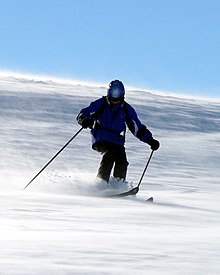Powder skiing

Deep snow skiing is skiing or snowboarding in deep, ideally completely untouched snow away from groomed slopes . Mastering the technique of deep snow skiing is essential for practicing freeriding , but free skiing also requires dealing with less favorable snow conditions.
Technique of deep snow skiing with skis
Skiing in all radii forms the basis for deep snow skiing. Visually, the skier is in the back position during the control phase, but if the body position is related to the ski, a swinging around the central position can be observed.
The technique for deep snow skiing is a parallel turn with active relief. This brings the skis above or close to the snow surface, as they can be turned more easily because of the lower resistance there. The subsequent immersion of the skis in the deep snow builds up a counterpressure that supports the next relief. This makes swings that follow one another much easier . This rhythmic repetition is called "deep snow swing". A closed ski guide results in buoyancy that makes deep snow skiing easier. Furthermore, it is important for controlled swing in deep snow to load both skis equally.
The right choice of snow and terrain is particularly important for good learning success. The easiest way to learn to ski deep snow is 10–20 cm freshly fallen, light snow on a firm surface with a relatively flat slope. The required rhythm can be practiced here. As the practice progresses, steeper slopes with deeper snow can also be chosen. However, the slab risk must always be taken into account. As the slope increases, so does the potential risk of a snow slab.
A short ski can be driven in a completely different way in extreme terrain: the body weight is shifted backwards from the diagonal run, the relieved skis "stand" briefly on their rear ends and can now be tilted towards the valley. The skis are in contact with the ground during the entire turn, which means that you can make corrections at any time. B. on an unexpected ice sheet.
This turn bears no resemblance to the "parallel turn with high relief" described above, which involves a powerful take-off with both legs in extremely steep terrain, turning the skis "in the air" by up to 180 degrees and the final powerful landing in an often unknown Requires terrain.
Deep snow skiing is much easier with the particularly wide deep snow skis: These skis always stay on the snow surface thanks to their large contact surface with the tips. The snow constantly pushes the skis upwards (the skis "float"). This makes them very easy to turn. The feel of these skis is similar to that of a snowboard.
Technique of deep snow skiing with a snowboard
With the exception of special deep snow skiing, deep snow skiing is technically demanding and difficult to learn. It's a lot easier with snowboarding. A certain speed is important, otherwise the rider cannot control the snowboard and can easily fall over. The sequence of movements when cornering is similar to that of standard drift turns on the slopes. However, the driver's focus is not on the edge of the snowboard, but on the snowboard surface. Moving the bindings of both feet to the rearmost position on the board or shifting the weight to the rear leg prevents the board tip from sticking into the snow, which is dreaded by beginners, which almost inevitably leads to a fall, often in a somersault. The movements to initiate turns are significantly softer, less dynamic and powerful than on the slopes. When driving fast, the driver can lean into the curve to compensate for the centrifugal force . Such speeds are only recommended if the view is absolutely clear, the terrain is level and the snow conditions and quality are perfect.



